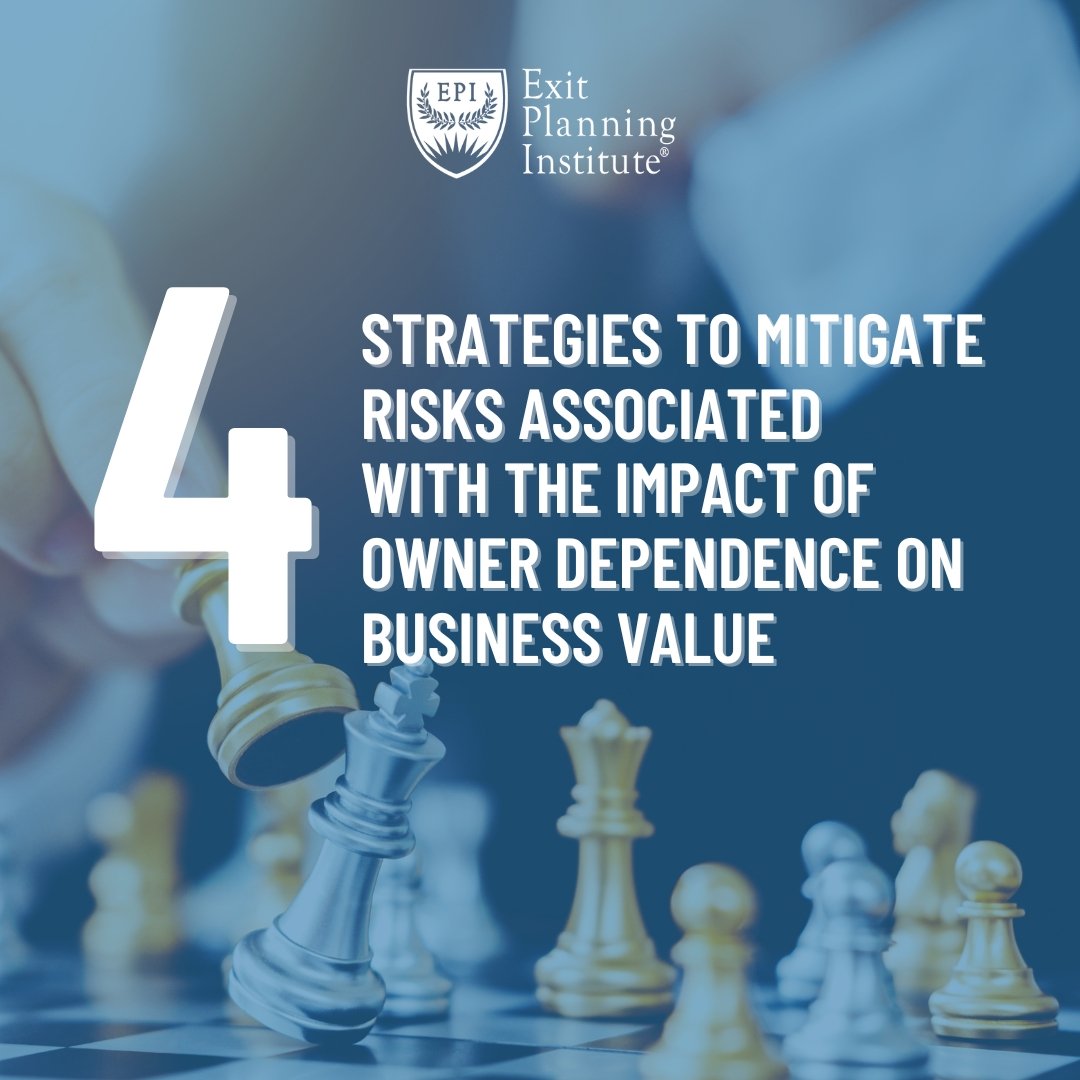
THE EXIT PLANNING BLOG
Keep up-to-date with exit planning, succession planning, industry trends, unique specialty insights, and useful content for professional advisors and business owners.
Share this
10 Pain Points Owners Run Into Before Selling Their Business
by Colleen Kowalski on September 19, 2022

Although enjoyable and a point of significant pride for owners, owning a business can also be stressful. For business owners thinking about their future and the future of their company, several pain points can arise during their exit planning process.
We spoke with four Certified Exit Planning Advisors (CEPAs) to gain a deeper understanding of the top 10 pain points business owners face before they exit their business.
Meet the Experts
Shina Culberson, President/Owner, Quist Valuation
As the President of Quist, Shina Culberson brings over two decades of financial and valuation experience to her leadership and guidance of the firm. Known for her direct style and laser focus, Shina specializes in business and securities valuation engagements for corporate finance, financial reporting, and tax purposes.
Prior to joining Quist, Shina was an Equity Analyst for Cohen Independent Research Group where she provided security valuation and investment recommendations on public companies in the biotech, high-tech, and entertainment industries. Additionally, she served as a Director at Charles Schwab Investment Management where she managed the International Credit Research Team covering international financial institutions and emerging market Asia and Latin America sovereign investments. The team covered over 50 debt issues and had oversight responsibility for approximately $32 billion in portfolio holdings.
Over the course of Shina’s successful career, she has participated in hundreds of valuation engagements for public and privately held companies in a number of industries including financial services, biotechnology, software, hardware, oil and gas, and entertainment.
Kyle Danner, Professional EOS Implementer®
Kyle Danner began his entrepreneurial career in his family’s printing company, where he became an owner and helped the firm grow from $ 2 million to $18+million in revenue. He then made the difficult decision to leave it all behind. His passion for helping people led to a degree in counseling, and his love for family business inspired him to help families grow, transition, or exit their businesses.
Since then, Kyle has expanded his focus beyond family business to working with organizations of all sizes and stages of growth. Along the way, he discovered that business owners and their leadership teams need a simple, practical way to run their companies. That’s why Kyle became a Professional EOS Implementer®. EOS®, the Entrepreneurial Operating System®, provides a structure and process to help business owners and their leadership teams clarify, simplify, and achieve their vision for the business.
Landon Mance, Co-Founder, Backbone Planning Partners
Landon Mance is a Financial Planner and co-founder of Backbone Planning Partners out of Las Vegas, Nevada.
Landon comes from a family of successful entrepreneurs and has a passion and excitement for serving the business community. This passion is what brought about the growth of Backbone Planning Partners to help business owners and their families. At Backbone Planning, we believe small business owners’ personal and business goals are intertwined, so we work with our clients to design a financial plan to support and help manage all aspects of their lives.
In 2019, Landon obtained the Certified Exit Planning Advisor (CEPA) designation through the Exit Planning Institute. With this certification, Backbone Planning Partners assists business owners through an ownership transition while focusing on a positive outcome for their employees and meeting the business owner’s goals. Landon is also a member of the Business Intelligence Institute (BII) which is a collaborative group that shares tools, resources and personnel, and offers advanced level training and technical support to specifically serve business owners. In 2021, Landon became a Certified Business Exit Consultant® (CBEC®) to help entrepreneurs plan to exit their businesses by counseling owners about exit options, estimating the value of the business, and preparing the business for exit and tax considerations.
Christine Trumbull, Founder, Pinnacle Exit Group
Christine Trumbull is the founder of Pinnacle Exit Group. She has over 28 years of experience in financial and business management that have led her to her current role: ensuring seamless transitions for founders and families.
She began her career as a CPA in the private industry eventually working her way up to Controller and CFO roles. After mastering public accounting she founded her own firm and later ran five highly profitable businesses with her husband. Following his passing, Christine decided to move into the next chapter of her career. She understands firsthand just how overwhelming the succession and exit of a business can be.
Owner Pain Points
1. Owner Dependency
Christine Trumbull shares, “One of the biggest problems I see is that the business becomes entirely dependent on the owner. Not only does it hinder their ability to grow and scale the business, but it devalues the business, potentially to a non-marketable point. Buyers want to buy the business, not the owner.”
Landon Mance echoes this sentiment. He says, “Go from an owner’s mindset to an investor’s mindset. You have to look at your business as a means to an end. You are not your business, and your business is not you. Look at it through this lens and it’ll help make decisions a little easier. If you’re thinking about or planning for a transition, start to make a list of what you would want if you were going out to buy a great business. Does your company have those traits?”
2. Lack of Personal Vision
Kyle Danner shares that a lack of personal vision for their life after their business negatively impacts many business owners. He continues to say, “Without a clear picture of life after exit, owners struggle with the motivation to start or to stay on course with their exit plan. As a former business owner, I delayed my exit because I wasn’t sure how to plan my next chapter. Despite the challenges, a business gives owners structure and purpose and it’s comfortable. In short, it’s what they know. The problem is they don’t know what they’re retiring to. Without that clear picture, they don’t prioritize personal planning.”
Christine Trumbull adds, “If an owner removes themselves from the ‘doing’ parts of the business, this frees his or her time to grow and manage the business. This provides more time, money, and freedom for other aspects of their life. Family, charity, maybe other business ventures. But the owner who remains stuck in the belief of ‘I’m the only one that can do this,’ doesn’t have the luxury of time, money, and freedom. What they have is a job.”
3. Weak or Nonexistent Leadership Team
Without a proper and well-functioning leadership team, an owner does not have the support system in place to effectively manage the business. The lack of a leadership team can diminish the value of the business and impact its readiness for a transaction. As Landon Mance states if the leadership team is “out of sync with the direction of the company” the owner will have a hard time trying to find a buyer for their business.
Kyle Danner shares the impact an owner-centralized business can have on the leadership team. He shares, “Since they’ve been the center of the business for so long, everyone defers to them, including long-term employees. It makes it difficult for owners to step away from the business. Ego isn’t always the issue. Often, it’s a personal and organizational habit. Everyone is used to going to them for decisions. The result is a leadership team unclear on their authority and lacking the cohesion needed to work as an extension of the owner.”
4. Poorly Defined Processes
Structural Capital is one of the Four Intangible Capitals that make up to 80% of a business’s value. Without clearly defined and documented processes, the business lacks the organization needed to effectively transition the company to a new owner.
Kyle Danner says, “Because they and their employees have been in the business for years, there is a lot of tribal knowledge or ‘we’ve always done it this way.’ It’s difficult for owners and their teams to formalize and document that knowledge and implement updated, more efficient ways of doing their work.”
Shina Culberson shares that not addressing the risks in an owner’s Intangible Capital has negative effects on business value. She says, “The ultimate impact of not understanding and addressing how the risks that Intangible assets impact value can lead to the business being unsellable. Business owners with high levels of intangible asset risk in many cases are forced to walk away from their business receiving no value.”
5. No Investment in Human Capital or Company Culture
Human Capital and Social Capital, or Company Culture, are two of the Four Intangible Capitals in a business. Without investing in their employees and considering how to advance their careers within the organization, owner’s run the risk of losing key employees, thus decreasing their business transferability.
Kyle Danner shares, “I have clients where office staff wants to work remotely, but those in the field or on the production line cannot. That creates tension between remote and nonremote workers, complicating building a robust and unified culture within the existing workforce while recruiting new talent. Owners and their leadership teams struggle with getting everyone in the organization on the same page, working for the greater good of the company.”
6. Siloed Operations
When owners fail to improve the four intangible capitals they ultimately end up with siloed operations. Each department does its own job without considering the impact on other areas of the business. This impacts efficiency, collaboration, and communication in the business.
Kyle Danner says, “When the company lacks a cohesive vision and has a weak leadership team, departments tend not to work well together, prioritizing their needs ahead of what’s best for the company and customers. They fail to see the bigger picture.”
He recommends incorporating the Entrepreneurial Operating System ® to help owners build value by aligning the company vision. Kyle shares, “EOS ® improves human capital by putting the right people in the right seats. It builds structural capital by strengthening processes that are documented and followed by all. It improves social capital by creating a cohesive culture. Finally, it builds customer capital with everyone on the same page on who the company serves and why.”
7. The Difference Between “Actual” and “Perceived” Business Value
Shina Culberson explains the importance of understanding your business’s actual value as opposed to what you perceive to be its value. She states, “A relatively high percentage of business owners do not have their business’ value determined until they are ready to sell. They often impute their own perceptions and opinions about their business value. These opinions are inaccurate, in some cases by as much as 2X. Opinion-based vs. actual valuations can lead to disappointment for eventual sale price.”
She continues, “Relying on the perceived vs actual value of the business often impacts actual sales proceeds, leading to disappointment and financial hardship. As many businesses are the primary source of net worth for their owners, there can be a severe impact to long-term personal life financial goals.”
Shina stresses the impact a valuation can have on a business. Her business, Quist Valuation, is a leading independent valuation and securities analysis firm with over 38 years of experience and expertise. Their services include software and established valuation methodologies and processes enabling them to support business owners and advisors throughout the entire business lifecycle.
8. Misaligned Operating Agreements
Operating Agreements define the decision-making processes, address continuity objectives in case of one of the 5 Ds, partner buyout processes, and determination of business value. Shina Culberson shares, “Poorly designed or out-of-date Operating Agreements can negatively impact a business’s ability to operate effectively and can in worst cases, cause irreparable harm to the business.”
Shina shares that one of her owner clients were impacted by misaligned Operating Agreements. She says, “In one example this issue caused an inability of the business to buy out the owner’s share of the business in a lump sum (impacting the financial stability of the owner’s family) and resulted in legal disputes and litigation over partner share rights and the value of the business. The business went out of business.”
9. Owner Burnout
One of the most common owner pain points is burnout. These owners have been working on and in their business for years and have reached the point where they would like to exit their business. Christine Trumbull shares, “More often than not, owners come to me with symptoms, with no real understanding of the cause. They are overwhelmed, stuck, and frustrated. They lack understanding of why it is when they work so hard, they just can’t seem to make it over that hurdle. They’ve gotten to a certain point but are fairly burnt out and disappointed with where they are. They are looking to exit, but don’t see how that can happen.”
10. Misinformation on Exit Planning
Some owners believe that “exit planning” is a process you begin months before you want to exit your business. However, this mentality does not allow time for proper value growth, risk mitigation, or due diligence.
Landon Mance says, “Unfortunately, most times it’s the pain points that are the catalyst for their desire to sell. If we get engaged with an owner in enough time, at least 5 years from their desired exit, we can help to alleviate some or all of them. However, more times than not, they’re looking to engage with someone to help get their business sold 6 to 18 months beforehand. Think about this – it takes you decades to build a great business and the problems that come along with it, you can’t undo those in 6-12 months.”
What Can Owners Do to Handle These Pain Points?
The idea of exiting their business can be stressful to owners. Even more so if they are afflicted by any of the pain points listed above.
Kyle Danner shares, “Any single issue listed is a heavy lift for an owner to address. Usually, it’s a combination that leaves them feeling overwhelmed and frustrated, keeping them stuck in the business, unable to progress towards their goals.”
However, by gaining a deeper understanding of the root cause of each pain point and mitigating the risk, owners can build significant value in their business prior to exit.
Learn more about building significant value in your business in our whitepaper.
Follow our socials for more exit planning content and strategies.
Share this
- Blog (544)
- CEPA (419)
- exit planning (249)
- CEPA community (187)
- Business Owner (170)
- Exit Planning Summit (95)
- EPI Chapter Network (89)
- Value Acceleration Methodology (79)
- Exit Planning Partner Network (76)
- EPI Announcement (49)
- Content (48)
- Webinars (37)
- Excellence in Exit Planning Awards (33)
- Marketing (30)
- 2024 Exit Planning Summit (28)
- 5 Stages of Value Maturity (26)
- Books (24)
- EPI Academy (24)
- EPI Team (22)
- Exit Planning Teams (22)
- Leadership (21)
- 2023 Exit Planning Summit (20)
- family business (20)
- women in business (19)
- Intangible Capital (18)
- Exit Options (17)
- Black Friday (16)
- CPA (15)
- Walking to Destiny (15)
- State of Owner Readiness (14)
- Chapters (13)
- Chris Snider (12)
- National Accounts (12)
- Small business (12)
- charitable intent (12)
- personal planning (12)
- Financial Advisors (11)
- Season of Deals (9)
- 5 Ds (8)
- About us (8)
- Podcast (8)
- Insiders Bash (7)
- Scott Snider (7)
- Christmas (6)
- Exit Planning Content Library (6)
- Case Studies (5)
- Owner Roundtables (5)
- Value Advisors (5)
- financial planning (5)
- Awards (4)
- Circle of Excellence (4)
- Exit & Succession (4)
- Five Ds (4)
- Three Legs of the Stool (4)
- executive training (4)
- Owners Forum (3)
- author (3)
- forbes (3)
- DriveValue (2)
- EPI Thought Leadership Council (2)
- Exit Is Now Podcast (2)
- Peter Christman (2)
- Veteran (2)
- Whitepapers (2)
- Business Owners Forum (1)
- SOOR (1)
- business consultants (1)






